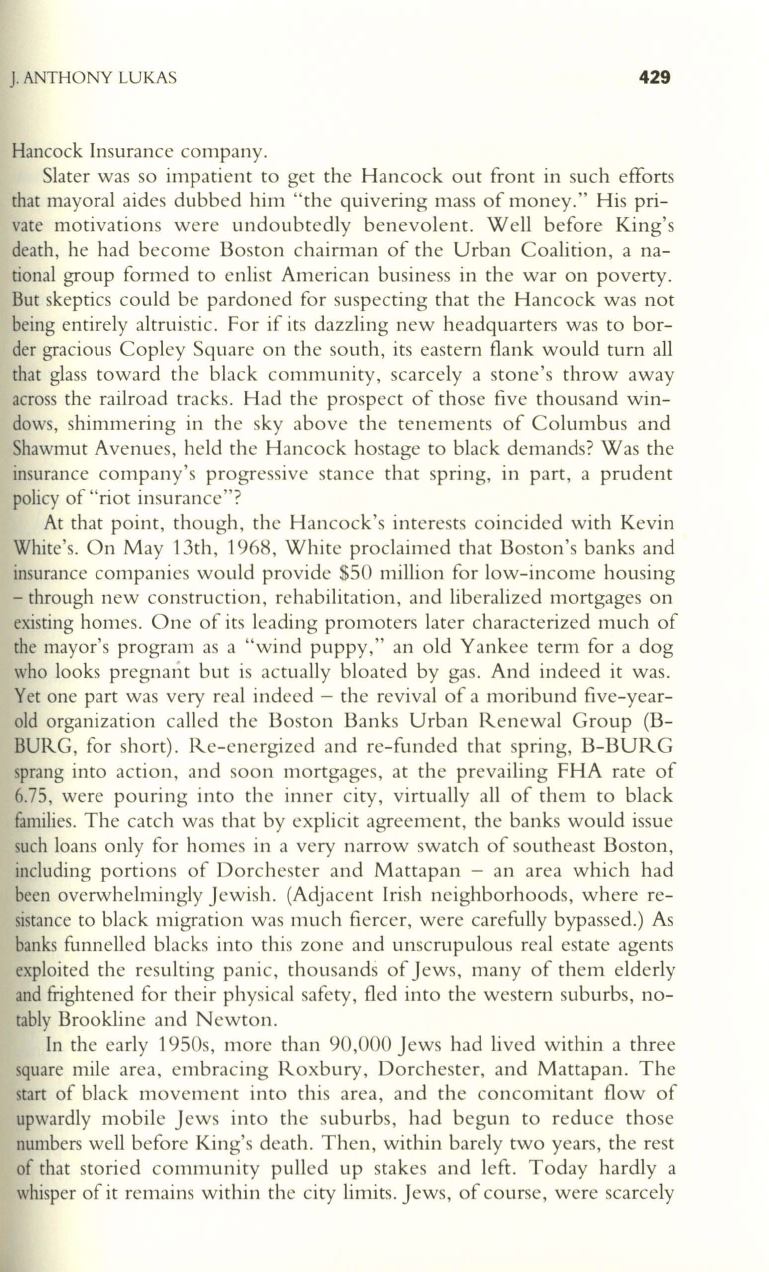
J.
ANTHONY LUKAS
429
Hancock Insurance company.
Slater was so impatient to get the Hancock out front in such efforts
that mayoral aides dubbed him "the quivering mass of money." His pri–
vate motivations were undoubtedly benevolent. Well before King's
death, he had become Boston chairman of the Urban Coalition, a na–
tional group formed to enlist American business in the war on poverty.
But skeptics could be pardoned for suspecting that the Hancock was not
being entirely altruistic. For if its dazzling new headquarters was to bor–
der gracious Copley Square on the south, its eastern flank would turn all
that glass toward the black community, scarcely a stone's throwaway
across the railroad tracks. Had the prospect of those five thousand win–
dows, shimmering in the sky above the tenements of Columbus and
Shawmut Avenues, held the Hancock hostage to black demands? Was the
insurance company's progressive stance that spring, in part, a prudent
policy of "riot insurance"?
At that point, though, the Hancock's interests coincided with Kevin
White's. On May 13th, 1968, White proclaimed that Boston's banks and
insurance companies would provide $50 million for low-income housing
- through new construction, rehabilitation, and liberalized mortgages on
existing homes. One of its leading promoters later characterized much of
the mayor's program as a "wind puppy," an old Yankee term for a dog
who looks pregnant but is actually bloated by gas. And indeed it was.
Yet one part was very real indeed - the revival of a moribund five- year–
old organization called the Boston Banks Urban Renewal Group (B–
BURG, for short). Re-energized and re-funded that spring, B-BURG
sprang into action, and soon mortgages, at the prevailing FHA rate of
6.75,
were pouring into the inner city, virtually all of them to black
families. The catch was that by explicit agreement, the banks would issue
such loans only for homes in a very narrow swatch of southeast Boston,
including portions of Dorchester and Mattapan - an area which had
been overwhelmingly Jewish. (Adjacent Irish neighborhoods, where re–
sistance to black migration was much fiercer, were carefully bypassed.) As
banks funnelled blacks into this zone and unscrupulous real estate agents
exploited the resulting panic, thousands of Jews, many of them elderly
and frightened for their physical safety, fled into the western suburbs, no–
tably Brookline and Newton.
In the early 1950s, more than 90,000 Jews had lived within a three
square mile area, embracing Roxbury, Dorchester, and Mattapan. The
start of black movement into this area, and the concomitant flow of
upwardly mobile Jews into the suburbs, had begun to reduce those
numbers well before King's death. Then, within barely two years, the rest
of that storied community pulled up stakes and left. Today hardly a
whisper of it remains within the city limits. Jews, of course, were scarcely


